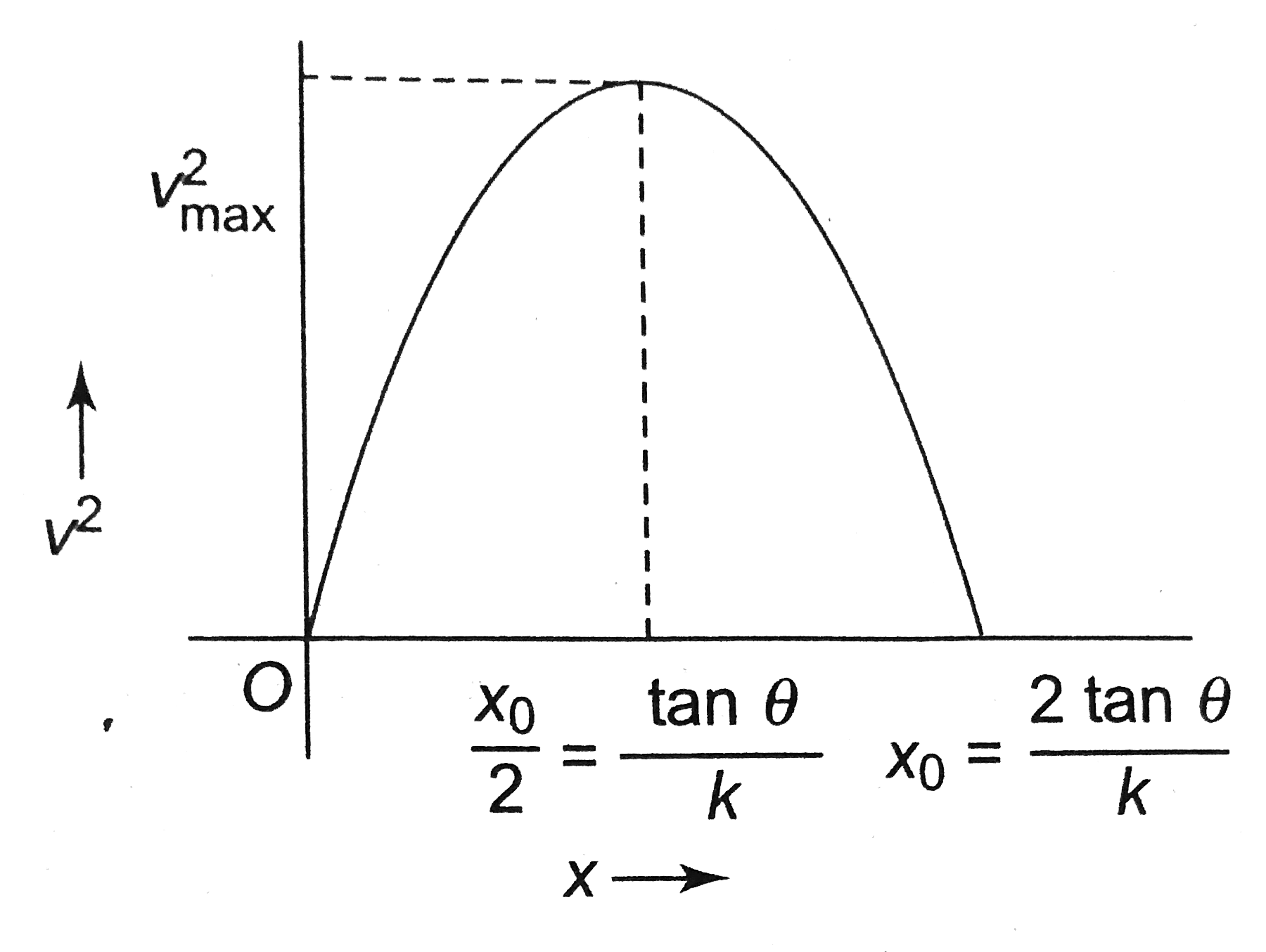A block sliding down on an inclined plane forms an angle θ with the horizontal. The friction coefficient depends on the distance x covered as μ=kx , where k is a constant. Find the distance covered by the block till it stops and its maximum velocity over this distance. Also , sketch a graph between square of velocity and distance covered x.
μ=kx
N=mgcosθ,f=μN=μmgcosθ
Along the plane : mgsinθ−μmgcosθ=ma
a=gsinθ−μgcosθ
μ=kx
a=gsinθ−kgxcosθ
vdvdx=gsinθ−kgxcosθ
∫v0vdv=∫x0(gsinθ−kgxcosθ)dx
v2=2gsinθx−kgx2cosθ
When the block stops , v=0
0=2fsinθx−kgx2cosθ
When the block stops , v=0
0=2gsinθx−kgx2cosθ
x=x0=2tanθk
Velocity will be maximum when a=0
a=gsinθ−kgxcosθ
0=gsinθ−kgxcosθ⇒x=tanθk=x02
v2max=2gsinθtanθk−kgcosθtan2θk2
vmax=√gktanθsinθ
v2v/sx
v2=2gsinθx−kgcosx2
Graph : y=2gsinθx−kgcosθx2 ( parabola , coefficient of x2is−ve , parabola open downward)
Note : (1). From x=0→x0/2,mgsinθ>f , acceleration its increasing.
2. At x=x0/2,mgsinθ=f , net force = 0 , the block is in equilibrium , velocity is maximum.
3. x=x0/2→x0,mgsinθ<f , retardation , velocity is decreasing and ultimately teh blocks stops.


Topper's Solved these Questions
Similar Questions
A small bar starts sliding down an inclined plane forming an angle α with the horizontal. The friction coefficient depends on the distance x covered as k=ax, where a is a constant. Find the distance covered by the bar till it stops, and its maximum velocity over this distance.
View SolutionA small block starts sliding down an inclined plane subtending an angle θ with the horizontal . The coefficient of friction between the block and plane depends on the distance covered from rest along the plane as μ=μ0x where μ0 is a constant . Find (a) the distance covered by the block down the plane till it stops sliding and (b) its maximum velocity during this journey .
View Solution
Knowledge Check
- Question 1 - Select One
A block of mass m slides down an inclined plane which makes an angle θ with the horizontal. The coefficient of friction between the block and the plane is μ. The force exerted by the block on the plane is
AmgcosθB√μ2+1mgcosθCμmgcosθ√μ2+1Dμmgθ - Question 2 - Select One
A small mass slides down an inclined plane of inclination θ with the horizontal. The co-efficient of friction is μ=μ0 x where x is the distance through which the mass slides down and μ0 a constant. Then, the distance covered by the mass before it stops is
A2μ0tanθB4μ0tanθC12μ0tanθD1μ0tanθ - Question 3 - Select One or More
A body is moving down a long inclined plane in inclination 45∘ with horizontal. The coefficient of friction between the body and the plane varies as μ=x/2, where x is the distance moved down the plane. Initially
x=0&v=0.AWhen x=2 the velocity of the body is √g√2m/sBThe velocity of the body increases all the timeCAt an instant when v≠0 the instantaneous acceleration of the body down the plane is
g(2−x)2√2DThe body first accelerates and then decelerates
A small block starts sliding down an inclined plane subtending an angle θ with the horizontal . The coefficient of friction between the block and plane depends on the distance covered from rest along the plane as μ=μ0x where μ0 is a constant . Find (a) the distance covered by the block down the plane till it stops sliding and (b) its maximum velocity during this journey .
View SolutionA body is moving down a long inclined plane of angle of inclination 'θ' for which the coefficient of friction varies with distance x as μ(x) = kx , where k is a constant . Here x is the distance moved by the body down the plane . The net force on the body will be zero at a distance x0 is given by ..........
View SolutionA body is moving down a long inclined plane of angle of inclination θ. The coefficient of friction between the body and the plane varies as μ−0.1x, where x is the distance moved down the plane. The body will have the maximum velocity when it has travelled a distance x given by :
View SolutionA body which was released from rest, slides down on an inclined plane of inclination θ. The coefficient of friction dowh the plane varies as μ=kx where k is a spositive constant and x is the distance moved by the body down the plane. The speed of the body 'v' versus distance 'x' graph will be as :
View SolutionA small mass slides down an inclined plane of inclination θ the horizontal the coefficient of friction is m=μ0x, where x is the distance by the mass before it stops is .
View Solution

